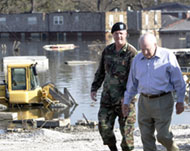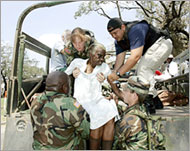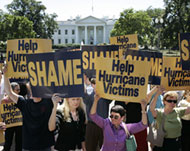New Orleans evacuation under way
More stragglers seem willing to flee the filthy water and stench of death as increasingly insistent rescuers make what may be their last peaceful pass through swamped New Orleans before using force.

“Some are finally saying, ‘I’ve had enough,” US Immigration and Customs Enforcement spokesman Michael Keegan said on Thursday.
“They’re getting dehydrated. They are running out of food. There are human remains in different houses. The smells mess with your psyche.”
Across a flooded city where as many as 10,000 holdouts were believed to be stubbornly staying put, police made it clear in orders barked from front porches and through closed doors that they would return – next time, getting tough.
Police said they were 80% done with their scan of the city for voluntary evacuees, after which they planned to begin carrying out Mayor Ray Nagin’s order to forcibly remove remaining residents from a city filled with disease-carrying water, broken gas lines and rotting corpses.
Last areas
“The ones who wanted to leave, I would say most of them
are out,” said Detective Sergeant James Imbrogglio.
“There may be a few left, so we’re going to go check one of our last areas that’s underwater today and then hopefully that will be it.”
 |
|
Vice President Cheney called the |
The job of carrying out the mayor’s order was left largely to the 1000 or so remaining members of New Orleans’ beleaguered police force.
“We are not going to be rough,” said Police Chief Eddie
Compass. “We are going to be sensitive. We are going to
use the minimum amount of force.”
The near-conclusion of the voluntary evacuation came as receding floodwaters revealed still more rotting corpses.
Nagin has said the death toll in New Orleans alone could reach 10,000, and state officials were ordering 25,000 body bags.
Mostly bodies
Volunteer rescuer Gregg Silverman, part of a 14-boat contingent from Columbus, Ohio, said he expected to find many more survivors in his excursion through the city’s flooded streets. Instead, he found mostly bodies.
“They had me climb up on a roof, and I did bring an axe up to where a guy had tried to stick a pipe up through a vent,” Silverman said.
|
“They are getting dehydrated. They are running out of food. There are human remains in different houses. The smells mess with your psyche” US Immigration and Customs Enforcement spokesman Michael Keegan |
“Unfortunately, he had probably just recently perished. His dog was still there, barking. The dog wouldn’t come. We had to leave the dog just up there in the attic.”
As for other bodies his group encountered: “Obviously we are not recovering them. We are just tying them up to banisters, leaving them on the roof.”
At St Rita’s Nursing Home in the town of Chalmette, authorities struggled to identify as many as 30 residents who may have perished.
Dangerous
Dr Bryan Patucci, coroner of St Bernard Parish, said the nursing home staff apparently believed it was more dangerous to move the residents than keep them at the building.
He said it may be impossible to identify all the victims until authorities compile a final list of missing persons.
 |
|
The floodwaters are polluted and |
The Army Corps of Engineers said the city was still about 60% flooded – down from as much as 80% last week – but was slowly being drained by 37 of the 174 pumps in the Orleans, St Bernard and Plaquemines parishes, and 17 portable pumps.
Together, those pumps can move 311 cubic metres of water per second, roughly equal to 432 Olympic-size swimming pools per hour.
Engineers said the mammoth undertaking could take months, and could be complicated by corpses getting clogged in the pumps.
Huge focus
“It’s got a huge focus of our attention right now,” said
John Rickey of the Corps. “Those remains are people’s loved ones.”
In Washington, the chief of the Environmental Protection Agency said the decision to pour heavily contaminated floodwaters from New Orleans streets into Lake Pontchartrain could pose future environmental problems.
 |
|
Police say there are around |
“We were all faced with a difficult choice,” EPA Administrator Stephen Johnson said.
The other option was to pour the water into the Mississippi River, where it eventually would move into the Gulf of Mexico.
Meanwhile, President George W Bush declared 16 September as a national day of remembrance for the dead, and he encouraged those displaced by the storm to sign up for $2000 debit cards to help rebuild their lives.
Congress also rushed to approve an additional $51.8 billion in emergency aid for the victims, on top of the $10.5 billion already provided. Bush signed the new spending bill on Thursday evening.
Cheney visit
Bush dispatched Vice President Dick Cheney to the region on Thursday amid persistent criticism of the sluggish pace of the federal response. Stopping along a street of splintered homes in Gulfport, Mississippi, Cheney said much progress is being made in a relief effort he termed “very impressive”.
As he spoke, a passer-by hurled an expletive at the vice president. “First time I’ve heard it,” Cheney joked with
reporters when asked if he was hearing a lot of such sentiments.
 |
|
Bush has been criticised for what |
Later in New Orleans, Cheney visited a repaired levee and surveyed the damage as he rode through the streets in an armoured Humvee.
At Louis Armstrong Airport, now a bustling military encampment, New Orleans’ City Council met for the first time since Katrina, with members defending how they handled the disaster and defiantly vowing to rebuild.
“New Orleans has been built back from many disasters,” said Councilwoman Cynthia Hedge Morrell. “New Orleans was here before there was a United States of America.”
No power
Some 400,000 homes in the city are without power, with no immediate prospect of getting it back. Where water has been restored, it is not drinkable.
The city is still dangerous – not primarily, as it was last week, from armed criminals, but from the sewage-laden floodwaters, which are believed to contain E coli and other dangerous germs.
Fires were also a continuing problem. At least 11 blazes burned across the city on Thursday, including a rash of fires that raged across the campus of historically black Dillard University, destroying three large buildings.